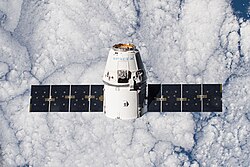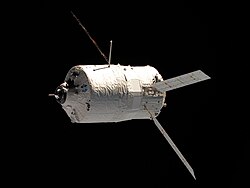Progress MS-4
| Progress MS-4 (Прогресс МС-4) | |||
| Beställare | Roskosmos | ||
|---|---|---|---|
| Tillverkare | RSC Energia | ||
| Modell | Progress MS | ||
| Operatör | Roskosmos | ||
| Uppskjutning | |||
| Startplats | Kosmodromen i Bajkonur | ||
| Raket | Sojuz-U | ||
| Uppskjutning | 1 december 2016, 14:52 UTC[1] | ||
| Omloppsbana | |||
| Banlutning | 51,6° | ||
| Dockning | |||
| Rymdstation | ISS | ||
| Kronologi | |||
| |||
Progress MS-4 (ryska: Прогресс МС-4) eller som NASA kallade den, Progress 65 eller 65P, var en rysk obemannad rymdfarkost som skulle leverera förnödenheter, syre, vatten och bränsle till Internationella rymdstationen (ISS). Uppskjutningen gjordes med en Sojuz-U-raket den 1 december 2016, från Kosmodromen i Bajkonur.
382 sekunder efter starten tappade man kontakten med farkosten. Farkosten och dess raket befann sig på 190 kilometers höjd och beräknas ha brunnit upp i jordens atmosfären över den ryska delrepubliken Tuva.[2]
Utredning
Enligt en första analys av data insamlad under uppskjutningen, ska Progress farkosten ha separerat från sin bärraketen drygt två minuter före den planerade separationen. Då raketen fortfarande var aktiv lede separationen till en kollision mellan de båda farkosterna.[3]
Källor och referenser
- ^ Manned Astronautics - Figures & Facts Arkiverad 15 mars 2017 hämtat från the Wayback Machine., läst 14 mars 2017.
- ^ Roscosmos, Progress MS-04 situation Arkiverad 22 januari 2017 hämtat från the Wayback Machine., läst 1 december 2016
- ^ Russianspaceweb, Progress MS-04 fails to reach orbit , läst 19 december 2016
| |||||||||||||||||||||||||
| ||||||||||||||||||||||||||||||||
| ||||||||||||||||
Media som används på denna webbplats
ISS Progress cargo spacecraft (NASA)
An unpiloted Progress 11 supply vehicle departs from the Pirs Docking Compartment on the International Space Station (ISS) at 2:42 p.m. (CDT) on September 4, 2003 for another month alone in orbit, as part of a Russian scientific experiment. It will then be deorbited with its load of trash and unneeded equipment and burn in the Earth's atmosphere.
A Progress supply ship linked up to the orbiting International Space Station (ISS) at 3:48 GMT, November 18, bringing Expedition 1 commander William M. Shepherd, pilot Yuri P.
Gidzenko and flight engineer Sergei K. Krikalev two tons of food, clothing, hardware and holiday gifts from their families. The photograph was taken with a 35mm camera and the film was later handed over to the STS-97 crew members
for return to Earth and subsequent processing.Backdropped by a cloud-covered part of Earth, the Orbital Sciences' Cygnus cargo craft approaches the International Space Station, photographed by an Expedition 40 crew member. The two spacecraft converged at 6:36 a.m. (EDT) on July 16, 2014.
ISS021-E-017623 (30 Oct. 2009) --- Backdropped by a cloud-covered part of Earth, the unpiloted Japanese H-II Transfer Vehicle (HTV), filled with trash and unneeded items, departs from the International Space Station. European Space Agency astronaut Frank De Winne, Expedition 21 commander; NASA astronaut Nicole Stott and Canadian Space Agency astronaut Robert Thirsk, both flight engineers, used the station's Canadarm2 robotic arm to grab the HTV cargo craft and unberth it from the Harmony node's nadir port. The HTV was successfully unberthed at 10:18 a.m. (CDT) on Oct. 30, 2009, and released from the station's Canadarm2 at 12:32 p.m.
This image, photographed by one of the Expedition 42 crew members aboard the International Space Station, shows the SpaceX Dragon cargo craft approaching on Jan. 12 2015 for its grapple and berthing and the start of a month attached to the complex. Dragon carried more than 2 ½ tons of supplies and experiments to the station.
ISS026-E-037172 (24 Feb. 2011) --- Surrounded by the blackness of space, the European Space Agency's "Johannes Kepler" Automated Transfer Vehicle-2 (ATV-2) approaches the International Space Station. Docking of the two spacecraft occurred at 10:59 a.m. (EST) on Feb. 24, 2011.












